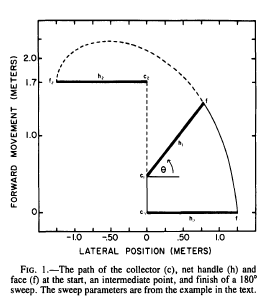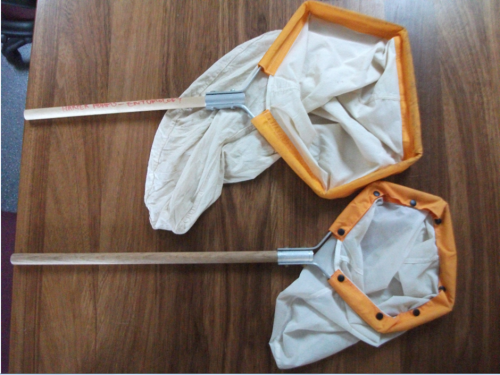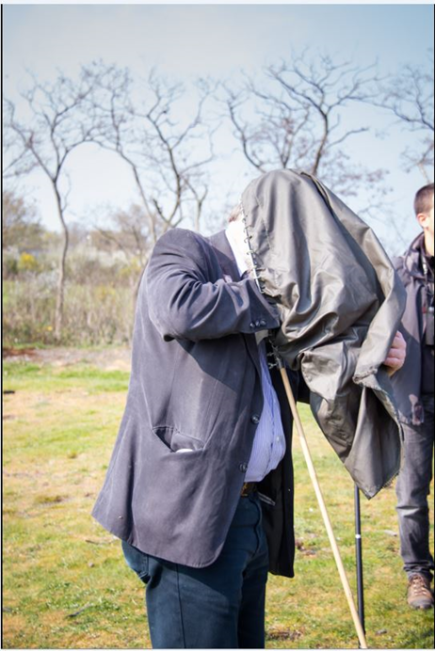I am certain that everyone who has studied biology at university and/or been on a field course, will have used a sweep net and heard the phrase “It’s all in the wrist”. Along with the pitfall trap it is the most commonly used entomological sampling technique used today. Although the premise is simple enough, a sturdy net, attached to a handle that is swept along, through or above low-lying vegetation, when used as a scientific tool and not just as a collecting device, things become somewhat more complex. The sweep net, as an insect collecting device, has been around for at least 180 years, the earliest reference that I have been able to find being Newman* (1835). There are a number of slightly later references in both general entomology texts and group specific books (e.g. Newman, 1844; Clark, 1860; Douglas, 1860; Douglas & Scott, 1865). Instructions for their use at this time are minimal, as this extract from Newman (1841) illustrates.
Newman (1841) a very brief description indeed.
This slightly later description of how to make a sweep net is, however, much more detailed, albeit somewhat sexist.
From Stainton (1852), although he seems to be quoting Newman. Apparently Victorian men were unable to sew.
More detailed, albeit fairly basic instructions on how to use a sweep net can be found in those two invaluable sources, Ecological Methods (Southwood & Henderson 2004) (two pages) and Practical Field Ecology (Wheatear et al., 2011) (one page). I was amused to see that the text in Southwood & Henderson was identical to that of the first edition (Southwood, 1966).
Now we come to the wrist action. There are a surprising number of ways in which you can swing a sweep net, but they all depend on the wrist moving your hand, and hence the net, in a figure of eight. The two most commonly used are what I think of as the one row side step, and the double front step. In the former you walk in a straight line swinging the net backwards and forwards at your side, ideal for sampling a row crop. The latter, the double front step, is similar, but instead of swinging the net at your side, you swing it side to side in front of you as you walk along. In a crop, this is great for sampling multiple rows, in a non-crop a good way of covering a nice wide area of vegetation. There are a further two techniques specifically designed for sweeping the upper part of vegetation, both originally devised for sampling soybean insects, the lazy-8 and the pendulum (Kogan & Pitre, 1980). Both these involve having the net raised, the lazy-8 with the net raised above the crop at the back and front swings, whereas in the pendulum, the net is kept within the crop on the fore and reverse swings. The final bit of wrist action, and arguably the most important and difficult to learn, is the flick-lock, which neatly seals the net and stops your catch escaping.
Having completed your sample of however many sweeps (remember a complete sweep is the figure of eight), and sealed your net, the next step is to transfer your catch to your collecting tubes, bags or jars. A good sweep net, as well as being made from tough material, should be a bit sock shaped. By this I mean that there is a ‘tail’ at the base of the net which helps make your catch more manageable if you are transferring directly to a plastic bag, as you are able to grab the net above the ‘tail’ end and push it into the collecting bag, before everting the net.
Two examples of sweep nets, a large and a small one. You can also get a medium one in this series supplied by the NHBS web site for about £34. http://www.nhbs.com/professional-sweep-net
When I was a student, the sweep nets we were supplied with, were large enough to stick not just your head inside, but also to get your arms in, so that you could Poot up anything interesting, your shoulders forming the seal to the net. Admittedly you did sometimes have an angry bee or wasp to contend with, but that was a rare event 🙂 Nowadays, sweep nets seem to be constructed on a much more modest scale, which makes sticking your head, let alone your shoulders into one, somewhat difficult.
Even the biggest modern one is too small for me to get my arms in to do some Pooting.
I was pleasantly surprised on an ERASMUS exchange visit to the University of Angers a few years ago, to find that the French, or at least those in Angers, were using sweep nets that were big enough for me to actually delve inside just as I did when I was a student 🙂
The joys of a sweep net with a view 🙂
Despite their undoubted popularity, value for money and relative ease of operation, there are a number of problems associated with sweep netting as a sampling technique. Although these problems are summarised elsewhere (Southwood & Henderson 2004; Wheater et al., 2011) I can’t resist putting my own personal slant on the subject.
- The type of habitat can have a marked effect on what you catch. Not all habitats are equally amenable to sweeping; spiny and woody vegetation poses more problems than a nice meadow and you need a really tough net for moorlands 🙂
- A sweep net doesn’t necessarily give you an accurate picture of the species composition of the habitat. Not all insects are equally catchable, you are for example, much more likely to catch Hemipterans than you are Coleopterans (e.g. Standen, 2000)
- The vertical distribution of the insects also affects what you catch. Many insects have favourite positions on plants e.g. the cereal aphid, Sitobion avenae prefers the ears and leaves, whereas the bird cherry-oat aphid, Rhopalosiphum padi is usually found at the bottom of the plant (Dean, 1974).
- The weather; anyone who has tried sweep netting during, or after, a rain storm knows that this is the ultimate act of folly 🙂 Wet nets and wet samples are not a marriage made in heaven.
- Time of day can also affect what you are likely to catch, pea aphids for example, are found at different heights on their host plants at different times of day (Schotzko & O’Keeffe, 1989). To be fair, this is of course not just a problem confined to sweep net sampling.
- Sweep nets have a fairly well-defined height range at which they work best, they are not good at sampling very short grass and once the vegetation gets over 30 cm you start to miss a lot of the insects associated with it as the net doesn’t reach that far down. Also the efficiency of the sweep netter is reduced.
- Finally, how the hell do you standardise your sweeps, not only between sweepers, but as an individual? Additionally, can you reliably use them quantitatively? This has been recognised as a problem for a long time (DeLong, 1932). No one disagrees that sweep netting, provided all the caveats listed above are taken into account, gives a very good qualitative and comparative idea of the arthropod community of the area you are sweeping and they have been so used in many important ecological studies (e.g. Menhinick, 1964; Elton, 1975; Janzen & Pond, 1975) and extensively in agricultural systems (e.g. Free & Williams, 1979; Kogan & Pitre, 1980). Comparing any sampling technique with another is difficult, and any attempt to quantify a catch so that specific units can be assigned to the area or volume sampled is welcome. This has been attempted for the sweep net (Tonkyn, 1980), although I confess that I have never seen anyone use the formula developed by him. In fact, although, according to Google Scholar his paper has been cited thirteen times, only one of the citing authors actually uses the formula, the rest just use him to cite sweep netting as a sampling method. Poor practice indeed.

An illustration of how the various components of the sweep net volume formula is derived (from Tonkyn, 1980).
Sweep nets are, despite the inability to get inside them anymore, great fun to use, extremely good at collecting material for ecology and entomology practicals and of course, a great ecological survey tool when used properly. Google Scholar tells me that there are over 38 000 papers that mention them. That many people can’t possibly be wrong 🙂
References
Clark, H. (1860) Catalogue of the Collection of Halticidae in the British Museum. Physapodes and Oedipodes Part 1. Published by the Trustees, London.
Dean, G.J. (1974) The four dimensions of cereal aphids. Annals of Applied Biology, 77, 74-78.
DeLong, D.M. (1932) Some problems encountered in the estimation of insect populations by the sweeping method. Annals of the Entomological Society of America, 25, 13–17.
Douglas, J.W. (1856) The World of Insects: A Guide to its Wonders. John van Voorst, London.
Douglas, J.W. & Scott, J. (1865) The British Hemiptera Volume I Hemiptera – Heteroptera. Ray Society, Robert Hardwicke, London.
Elton, C.S. (1975) Conservation and the low population density of invertebrates inside neotropical rain forest. Biological Conservation, 7, 3-15.
Free, J.B. & Williams, I.H. (1979) The distribution of insect pests on crops of oil-seed rape (Brassica napus L.) and the damage they cause. Journal of Agricultural Science, 92, 139-149.
Janzen, D.H. & Pond, C.M. (1975) A comparison, by sweep sampling, of the arthropod fauna of secondary vegetation in Michigan, England and Costa Rica. Transactions of the Royal Entomological Society of London, 127, 33-50.
Kogan, M. & Pitre, H.N. (1980) General sampling methods for above-ground populations of soybean arthropods. Pp 30-60 [In] Sampling Methods in Soybean Entomology. (Eds.) M. Kogan & D.C. Herzog, Springer, New York.
Menhinick, E.F. (1964) A comparison of some species-individuals diversity indices applied to samples of field insects. Ecology 45, 859-861.
Newman, E. (1844) The Zoologist. A Popular Miscellany of Natural History, Volume 2. John van Voorst, London.
Newman, E. (1841) A Familiar Introduction to the History of Insects. John van Voorst, London.
Newman, E. (1835) The Grammar of Entomology. Frederick Westley & A.H. Davis, London.
Schotzko, D.J. & O’Keeffe, L.E. (1989) Comparison of sweep net., D-Vac., and absolute aampling., and diel variation of sweep net sampling estimates in lentils for pea aphid (Homoptera: Aphididae)., Nabids (Hemiptera: Nabidae)., lady beetles (Coleoptera: Coccinellidae)., and lacewings (Neuroptera: Chrysopidae). Journal of Economic Entomology, 82, 491-506.
Southwood, T.R.E. (1966) Ecological Methods, Methuen & Co., London.
Stainton, H.T. (1852) The Entomologist’s Companion; Being a Guide to the Collection of Microlepidoptera and Comprising a Calendar of the British Tineidae. John van Voorst, London.
Standen, V. (2000) The adequacy of collecting techniques for estimating species richness of grassland invertebrates. Journal of Applied Ecology, 37, 884-893.
Tonkyn, D.W. (1980) The formula for the volume sampled by a sweep net. Annals of the Entomological Society of America, 73,452-454.
Wheater, P.C., Bell, J.R. & Cook, P.A. (2011) Practical Field Ecology: A Project Guide, Wiley-Blackwell, Oxford.
*Of interest to me, but perhaps not to my readers, Edward Newman was one of the founder members of the oldest and most exclusive, yet low-key, entomological society in the world, The Entomological Club, of which I have the honour of being a member 😊 https://en.wikipedia.org/wiki/Edward_Newman_(entomologist) founder member of the Entomological Club






I use a four-fold insect net and the battering it gets every year puts me through half a dozen bags at least. I constantly have to sew it up in the field. On one notable occasion I had cotton thread, but no needle. Disaster? No, I used a fresh pine needle instead. Ray Mears could learn a thing or two from me.
LikeLiked by 1 person
Expensive at £15 a go 🙂
LikeLike
Pingback: Entomological Classics – The Beating Tray or Japanese Umbrella | Don't Forget the Roundabouts
Pingback: The Roundabout Review 2019 – navel gazing again | Don't Forget the Roundabouts